PinotFile: 11.26 July 14, 2018
|
The Making of a Glorious ChardonnYAY: Winemaker Michael Zardo of Ten Acre Winery Tells How He Did It
Chardonnay is a polarizing wine that is beloved by a large number of wine consumers who shout, “ChardonnYAY!, yet decried by a smaller number of other wine drinkers who proclaim, “Anything but Chardonnay.” Chardonnay can be poles apart stylistically from examples that are opulent, tropical, buttery and oaky to more lean versions that are fermented in stainless, undergo no malolactic fermentation, and are acid-driven. Arguments inevitably ensue about what style is best. Chardonnay is a varietal that is highly amendable to the winemaker’s hand. There is a myriad of decisions to be made beginning in the vineyard and ending almost twelve months later at bottling. After tasting and reviewing the 2015 Ten Acre Winery Ritchie Vineyard Chardonnay, I asked winemaker Michael Zardo to describe in some detail exactly how he crafted that wine. Michael Zardo (his friends simply call him “Zardo”) has a degree in enology from Fresno State University. Before joining Ten Acre, he spent seven years as an assistant winemaker at Pisoni Vineyards & Winery. Prior to that, he worked at Bernardus Winery and spent two winemaking seasons in New Zealand.
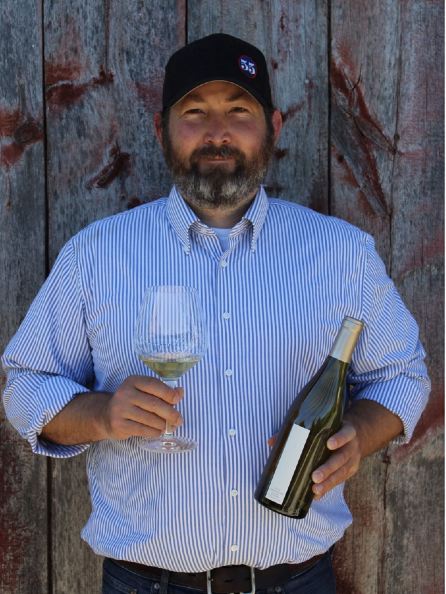
In Zardo’s own words: Introduction One thing that makes Chardonnay so fascinating is how versatile it is in terms of how a winemaker is able to shape it. It can be big and opulent, or austere, focused and nervy, depending on how heavy or light a hand the winemaker applies. The majority of Chardonnay that I make tends to fall between these two extremes. When it comes to working with a Grand Cru-caliber vineyard like Ritchie (or any other great vineyard), my goal is to let the site express its personality. At the same time, I love a beautifully textured Chardonnay - I want people to feel the shape and presence of the wine in their mouth. I also believe a great Chardonnay should have excellent acidity, with layers and layers of complexity. With nearly twenty vintages under my belt, the wines that excite me the most are the ones that come from unique vineyards that have an authentic and distinctive personality.
Selecting Ritchie Vineyard When I look for a great Chardonnay vineyard, there are a few things that I always take into consideration. These things include soil, rootstock, clonal selections trellis systems, water, climate, vine age, and of course the vineyard manager or farmer. Ritchie Vineyard is located in the center of the Russian River Valley AVA and is one of those truly rare sites where everything has come together to produce a world-class Chardonnay vineyard. When I first started to make wine for Ten Acre in 2010, the owners of the winery, Scott and Lynn Adams, asked me if there were any vineyards I really wanted to work with. I immediately said that I would love to work with the Chardonnay from Ritchie Vineyard. They told me to start calling, so I did. In fact, it took two years of calling (sorry Kent Ritchie!) before we finally were given a block of Ritchie Chardonnay in 2012.
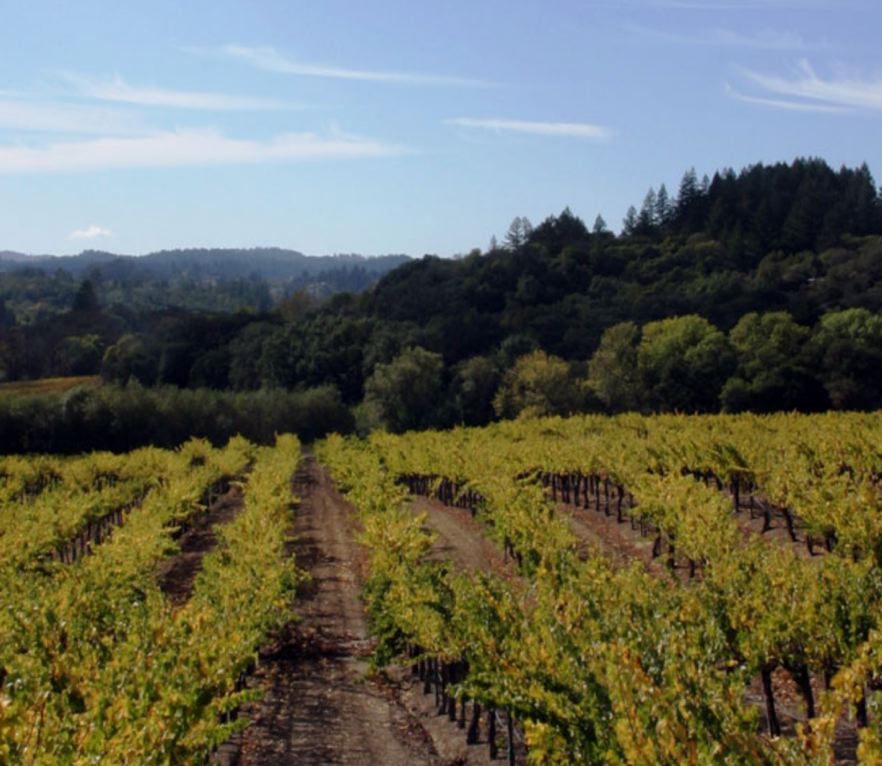 Our first block was comprised of relatively younger vines that had been planted in 2004. While the clonal material was the same as Ritchie’s rightfully sought-after 1972 Wente clone plantings, the younger vines are on the newer 101-14 rootstock, while the original vines at Ritchie are on AXR. In 2014, we were thrilled when we were also given access to some fruit from the 1972 plantings. Our 2015 Ritchie Vineyard Chardonnay is made from approximately 60% of the 1972 Wente clone grapes, with the remainder being the 2004 plantings. The old vine grapes add lovely richness and viscosity to the mouthfeel, along with more tropical elements of mango, peach and pineapple, while the more youthful vines provide great natural acid, minerality, and very pure citrus notes. I love how these two different blocks work together. In fact, when we were given the opportunity to take all of our fruit from the old vines, we decided to keep working with both sections as we believe this adds to the unique character and complexity of the wine.
Viticulture and Harvest There are many ways to make good Chardonnay, but it all starts in the vineyard. Working with Kent Ritchie and his team, this begins in the offseason, with shoot and canopy management. This includes training the shoots upward and separating the clusters. We also drop fruit to about two clusters per shoot and remove the laterals to create airflow around the clusters, helping to prevent botrytis and mold.
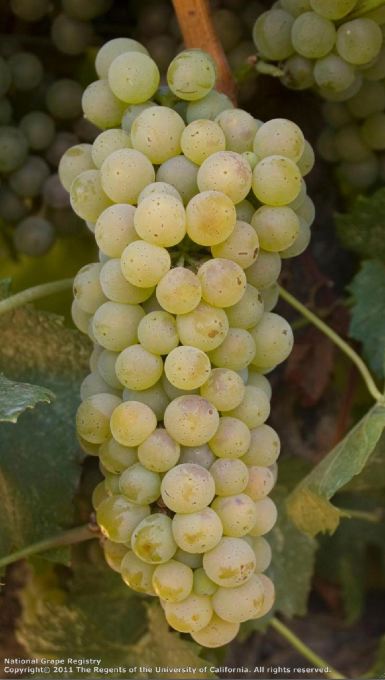 My ideal harvesting numbers are generally from 23.5º-25.0º Brix, 3.15-3.30 pH (at harvest - this goes up in the finished wine), and a TA between 7.5 and 9.0. Of course, there is room to shift up and down based on how the grapes taste, which was true in 2015 when we picked at 25.3º Brix because the grapes tasted so good! I usually start planning to harvest about five days out, and I sample the grapes regularly during this period since Brix can increase a full degree in a day, depending on what Mother Nature has in mind. I harvest at night so the grapes come into the winery cold. Night harvesting really helps with microbial stability and mitigates any unwanted daytime dehydration of the grapes.
In the Winery Once the grapes are in the winery, we hand sort the clusters meticulously. We have a great team, and I tell them if you wouldn’t want to eat the grapes from a cluster, then throw the cluster out. Once sorted, we whole cluster press the grapes using as minimal rotations of the bladder press as possible, which preserves the integrity of the juice. I am constantly tasting the juice as it comes out of the press to make the press cut. When the pH starts to rise, I am right there and ready. I stop the press cycle and separate the hard press, with only free-run juice used in the wine. This eliminates any chance of astringency in the finished wine. I then add SO2 mix to the tank with N2 and cold settle the juice for 24 hours. This allows the heavy lees to settle while leaving some solids to contribute to the final mouthfeel of the wine. Once the juice has settled, the juice is barreled down to its home for the next 11 months.
Fermentation and Barrel Selection The 2015 Ritchie Vineyard Chardonnay was 100% barrel fermented, and like all of our Ten Acre Chardonnays, the initial fermentation was done with native yeast. I find this gives the wine a more complex mouthfeel (again, texture is so important to me). The Chardonnay only sees SO2 once in tank before barreling down. After that, the wine is protected by the CO2 that we naturally created during fermentation. Once the native yeast starts fermentation, I begin stirring the wine in the barrels every day. This helps keep the yeast in suspension, which, in turn, builds mouthfeel. As the fermentation slows down, I reduce the stirring to once a week. I do inoculate for the secondary malolactic fermentation because of how delicate the wine is at this stage. Essentially, any microbe that could metabolize malic acid could take over at this point. I continue weekly lees stirring until the secondary fermentation is complete. Once all the malic acid is gone, I wait a couple of weeks to add SO2. I wait in order to eliminate the chance if any diacetyl in the wine profile, while letting the vineyard’s abundant fruit to come back to the forefront. When choosing barrels for our Chardonnays, I like to use a variety of coopers, toast levels and forests. Each barrel I selected was chosen to accentuate different aspects of the Ritchie Chardonnay, with the goal of creating a very complex and layered wine. You often hear that barrels are a winemaker’s spice rack, and I am not someone who would want to season my food with just pepper. For this wine we used DAMY, Francois Frères, Louis Latour, and Taransaud French oak barrels. In broad strokes, the DAMY barrels have an amazing quality where heavy toast accentuates the plush, velvety textural characteristics that I prefer. The medium toast Francois Frères barrels provide some nice spice. The Louis Latour barrels, which have a “house toast,” impart a subtle coconut oil character that I really enjoy when it is a subtle part of the blend. The “Pure T” Taransaud barrels brighten the acidity, while also accentuating textural elements. Overall, 40% of the Ritchie Vineyard Chardonnay was aged in new French oak barrels. Generally, I find the sweet spot for new oak to be between 30% and 40%. While the remaining barrels were most one-year-old, they were steamed twice, and essentially acted like neutral barrels. The result was to limit the overall oak imprint, and allow the more delicate vineyard notes shine through. I am very judicious with new oak for I believe it needs to be in harmony with every other element of the wine, without masking any of the vineyard’s personality.
Blending and Bottling In order to craft a wine that I believe most profoundly expresses the unique attributes of Ritchie Vineyard, I made the wine as a selection of our very favorite barrels. The 210 cases produced represented just under 40% of the total wine made from the vineyard in 2015. The evaluation process happened over many months, and was a process that was done in collaboration with the winery’s owners who are very hands on. We first start tasting in January, and by April we are beginning to select our favorite barrels. In June and July, we begin playing with the different components and start refining our overall vision for the blend. Across the board, the quality from Ritchie Vineyard was exceptional in 2015, so we had a lot of great wine to work with. By the end of July, Lynn, Scott and I had decided on the final blend. We bottled the wine in mid-August after 11 months in barrel, and the wine was bottled without fining or filtration to avoid stripping away the more nuanced qualities of the wine. The result is a wine that drinks beautifully upon release, but one that will evolve over time with age. It is the kind of wine that made me fall in love with Ritchie Vineyard in the first place. “Aromas of tropical fruit, warm hay, honeysuckle, lemon zest and shortbread rise from the glass. On the palate, the flavors are lush and juicy, with layers of fresh apricot, peach and lemon, all underscored by a refreshing brightness that leaves you wanting more. Enjoy this wine now through 2024.
2015 Ten Acre Ritchie Vineyard Russian River Valley Chardonnay 14.4% alc., pH 3.55, TA 0.63, 210 cases, $55. Wente heritage clone, planted in 1972 and 2004. Yield 3.0 tons per acre. Fermented and aged in French oak barrels, 40% new. Full malolactic fermentation. Bottled unfined and unfiltered. · Moderate golden yellow color in the glass. This is clearly a special wine from the first whiff and taste. Enticing aromas of lemon creme, white-fleshed fruit, white flower blossoms, honey, and the slightest spice and vanilla pick up intensity over time in the glass. Great polish and balance make for exceedingly easy drinking. Velvety in the mouth without oiliness, offering fresh flavors of lemon, pineapple, coconut, apricot and a subtle compliment of oak peeks from the background. A juicy arrow of sound acidity is at the heart of the wine. The finish is dry and quenching and urges another sip. This wine seduces rather than attacks the senses and is truly Chardonnay nirvana. Score: 97
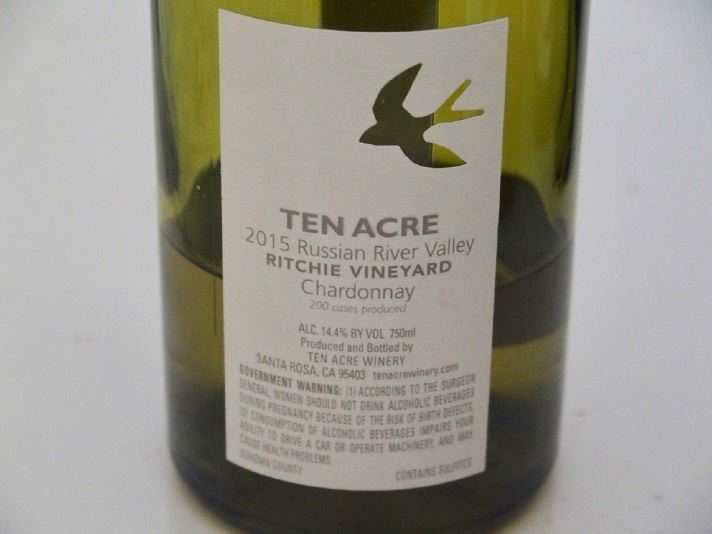
Ritchie Vineyard: California’s Legendary Grand Cru Chardonnay Vineyard
 Kent chose a northwest-facing hillside in the heart of the Russian River Valley, located on a bench at the intersection of the Russian River, the Santa Rosa Plain and the Laguna de Santa Rosa, each of which influences the vineyard’s terroir. The site is exposed to the cooling effects of coastal fog that burns off in the late morning, and benefits from the well-drained sandy Goldridge soil speckled with gravel. The ideal climatic conditions for Chardonnay include 2796.15 growing degree days, and annual rainfall of 29.9 inches with 5.82 inches during the growing season.
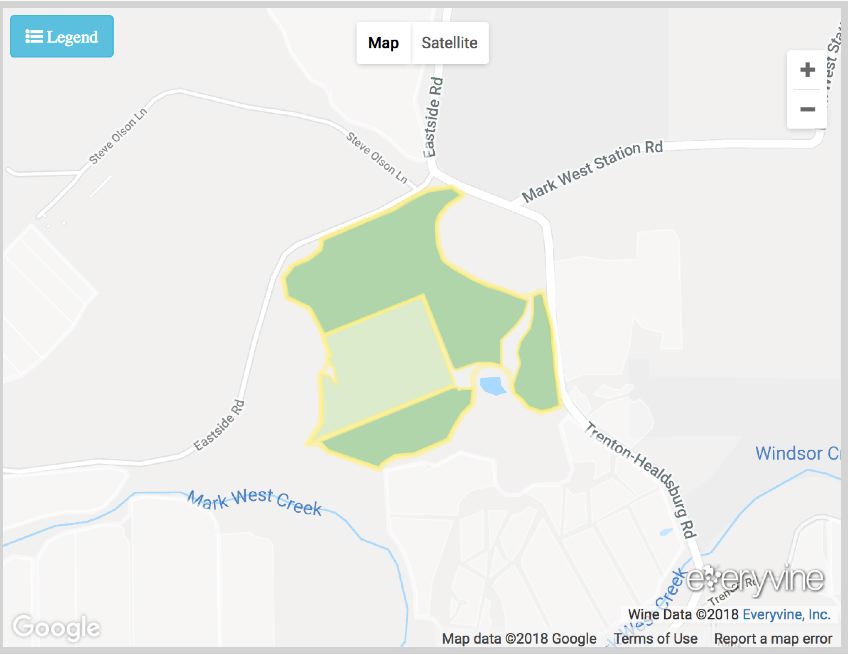 Additional plantings of Wente selection were added in 2004, and today Ritchie Vineyard consists of nearly 70 acres of Chardonnay. The vines are widely spaced at 968 vines per acre and are low yielding with an average of 2.5 tons per acre. The feature that stands out with Chardonnay at Ritchie Vineyard is superb intensity of fruit flavors in combination with scintillating tension and vibrancy. Melissa Apter Castro, the winemaker for Metzker Family Estates who crafts a Ritchie Vineyard Chardonnay, told me the following about this treasured vineyard and its owner. “There is a reason Ritchie Vineyard is known as a legendary site for Russian River Valley Chardonnay. Not only is the quality of the grapes fantastic, but the passion and personal touch Kent Ritchie gives to each block is wildly apparent the second you turn off of Eastside Road onto the gravel road of Ritchie Vineyard. His hand-painted wooden signs dictate people to “Drive Slow,” and notify visitors who are contracted to each block. This personal touch makes you feel like you are truly part of something meaningful and not just a number stepping in line to buy a product and leave. I believe everyone who purchases fruit from Ritchie Vineyard feels like they are at a home away from home every time they visit. During vineyard walks with Kent, he is jovial, observant and humble. After over forty years of owning and managing this site, he still has a twinkle in his eyes when meeting with clients and waling the rows.” I met Kent at a Sonoma County charity auction a few years ago, and agree with Melissa’s description of his engaging personality.
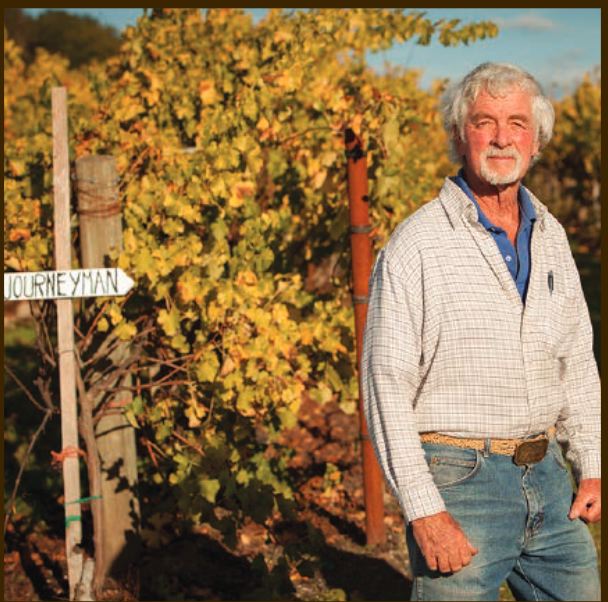 Castro went on to say the following. “The 40+-year-old Wente clone vines retain so much natural minerality and acidity that the wines are fresh and vibrant when aged in higher percentages of new French oak. The Chardonnay I make for Metzker Family Estates is a wine I like to call Old World meets New World Chardonnay. With the 60%-70% new French oak (depending on the vintage), I get notes of brioche, toast and hazelnut you often find in a true California, full malolactic fermented Chardonnay. But the finish on this wine is so reminiscent of a Chablis or Italian white with clean minerality, bright acidity and citrus notes. The wine does not fall short or leave a heavy presence in your mouth. I find that the Ritchie Chardonnay appeals to both the Chardonnay only fans as well as the consumers who claim they do not drink Chardonnay. I have seen plenty of people become Chardonnay fans after drinking a Ritchie Vineyard Chardonnay.” Many of California’s greatest Chardonnay producers have sourced grapes from Ritchie Vineyard: Ancient Oak Cellars, Arista, Aubert, Bevan Cellars, Bjornstad Cellars, Boich Family Cellars, Chateau Boswell, Croix, De Loach, Domaine Della, DuMOL, Flanagan Wines, Gary Farrell Vineyards & Winery, Hertelendy, Joseph Swan, Kobler Estate Winery, La Follette, MacRostie, Metzker Family Estates, Montagu, Patz & Hall, Paul Hobbs, Ramey, Red Car Wine Co, Ten Acre and Woodenhead. Here are some Ritchie Vineyard Chardonnays recently reviewed. NOTE: I think you will have a much better handle on the aromas and flavors of Chardonnay if the wines are tasted or drunk at about 63ºF, similar to the temperature that I prefer to taste or drink Pinot Noir.
2016 Bevan Cellars Ritchie Vineyard Russian River Valley Chardonnay 14.6% alc., $65. · Moderately dark golden yellow with a light apricot hue in the glass. Aromas of ash, tobacco and white pepper with no fruit showing up over time. Viscous in the mouth with a richness of ripe flavors including lemon curd, pineapple, ripe apricot, and tropical fruits. Clearly, the fruit was left hanging a long time. Oak-driven flavors of toast and smoke intrude. Somewhat heavy in the mouth, lacking vibrancy, and slightly hot on the finish. No vineyard typicality in this version. Score: 87
2016 Chateau Boswell Ritchie Vineyard Russian River Valley Chardonnay 14.3% alc., 225 cases, $95. Susan Boswell proprietor and Philippe Melka winemaker. · Moderately light golden yellow color in the glass. Nicely perfumed with aromas of lemon zest, apricot, white flower blossom and brioche. Very seductive in the mouth, with a sleek but not viscous mouthfeel, offering flavors of lemon, pineapple, pear and mango with complimentary oak highlights chiming in. Beautifully balanced, with a delightful evanescent finish. A true reflection of the vineyard terroir. Score: 95
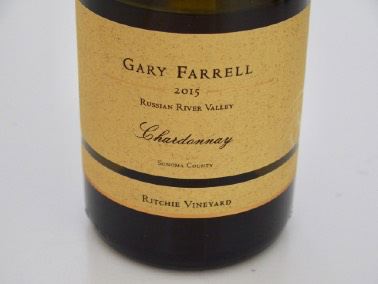 2016 Gary Farrell Ritchie Vineyard Russian River Valley Chardonnay 13.9% alc., pH 3.24, TA 0.66, 95 cases, $65. Harvest Brix 22.0º-23.0º. Harvested in cool morning hours, gently whole cluster pressed, allowed to settled at chilled temperature for 24 hours before inoculating with Montrachet yeast. Fermented and aged in French oak barrels, both light and medium toast barrels and 500-L puncheons (Francois Frères, DAMY, Dargaud & Jaegle and Cavin), 35% new for 9 months. Racked off primary lees once before bottling. · Moderate golden yellow color in the glass. Leading off are lovely aromas of delicate flint, lemon custard and lime. Somewhat lean, yet flavorful, offering tastes of lemon-lime, grapefruit, white peach and caramel. Oily on the palate, with plenty of righteous acidity keeping the wine lively and edgy through the clean and quenching finish. Score: 94
2016 Montagu Ritchie Vineyard Russian River Valley Chardonnay 15.2% alc., 101 cases, $60. · Moderate golden yellow color in the glass. Aromas of lemon zest, buttered toast, warm biscuit and ashtray. Rich, creamy and toasty in the mouth, offering flavors of ripe peach, grilled pineapple, caramel and char. Oak overrides the core of very ripe fruit flavors, the wine lacks acid verve, and there is the slightest sense of alcohol on the finish. Score: 87
2014 Ramey Ritchie Vineyard Russian River Valley Chardonnay 14.5% alc., 1,250 cases, $65. Old Wente selection planted in 1972. Harvest Brix 23.5º. Native yeast and full malolactic fermentation in barrel, with lees stirring. Aged 19 months in Francois Frères French oak barrels, 30% new. Fined but not filtered. · Moderately light golden yellow color in the glass. Enticing aromas of lemon oil, kiwi, green apple, slate and the slightest matchstick. Seductively oily, with fresh flavors of citrus, apple and coconut. Inviting harmony, with the right bit of toasty oak, and some finishing persistence. This wine walks the line between fruit richness and wholesome acidity. Score: 93
Past Reviews of Ritchie Vineyard Chardonnay
Chardonnay Smackdown
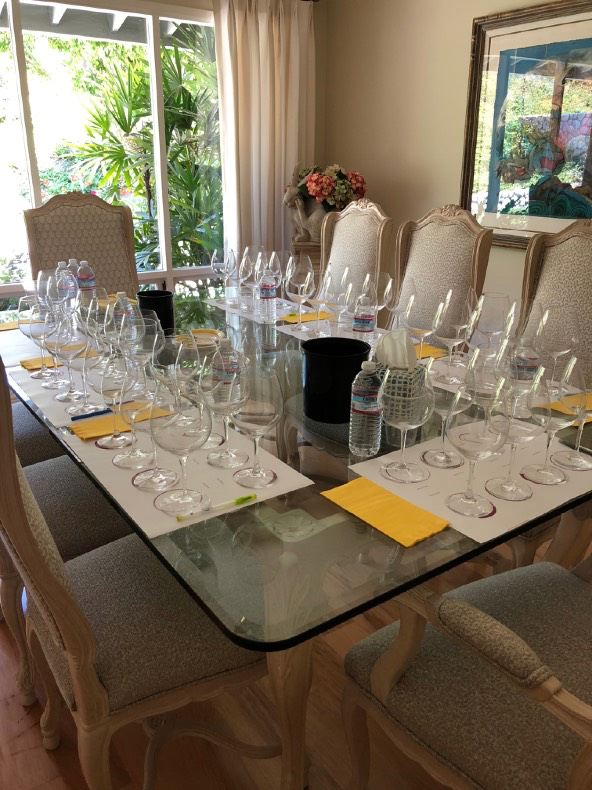 David provided me with some interesting facts about Australian Chardonnay. Historically, Australian wines traditionally consisted of fortified wines such as Port or Sherry. However, there has always been a little of what was called table wine. These table wines were modeled after European wines so they were given names like Claret, Burgundy, Hock and Riesling. The grape varieties were not important and all sorts of grape varieties were blended together. Wines that had less floral flavors were called Chablis or White Burgundy. The Australian wine known today as Chardonnay is a relatively recent arrival. The wine is named after the grape variety and must comprise at least 85% of the named varietal. The first Chardonnay vines arrived in Australia in 1862 through the efforts of James Busby, but the first commercial production of Chardonnay by Tyrrells did not happen until 1971. For a wine that is so fundamental to Australian wine, it is stunning that Australia only started working with it in 1971! Australian Chardonnay started our as a very rich and buttery styled wine with alcohols around 14%-14.5%. The earliest Australian Chardonnays were fermented in stainless steel and then aged in oak. They did not undergo malolactic fermentation. Eventually, the Australians adopted fermentation and aging in French oak and complete malolactic fermentation. The ultimate example of this style was the Rosemount Show Reserve Chardonnay that was oak, buttery and alcoholic. When the first of the hipster generation arrived, they said the Rosemount Show Reserve style was yesterday’s wine and decided to make a “Chablis” style of Chardonnay instead. This style often did not undergo malolactic fermentation and had very little oak flavor. Eventually, change followed, and the Australian Chardonnay market now offers a range of styles. The wines and some impressions. Not a bad wine in the bunch.
California 2015 Pahlmeyer Napa Valley Chardonnay $80. The most identifiable wine blind. Very oaky, big, ripe and creamy. Still, I would drink this wine and not complain too much. 2015 Cattleya Pratt Vineyard Russian River Valley Chardonnay 14.2% alc., $70. Superb in every way. I scored this wine 94 when reviewed previously. My favorite wine in this tasting along with the Paul Lato bottling. 2015 Rhys Alpine Vineyard Santa Cruz Mountains Chardonnay 13.0% alc., $79. Loaded with citrus fruit and shot through with excellent acidity, even high-strung. Seems less than full malo. 2016 Paul Lato East of Eden Pisoni Vineyard Santa Lucia Highlands Chardonnay 14.5% alc., $80. Fruit veers to the ripe side featuring peach and tropical notes, but flat-out delicious. Seductively creamy in the mouth with enough acidity to avoid heaviness and the right touch of oak. My favorite Chardonnay in this tasting.
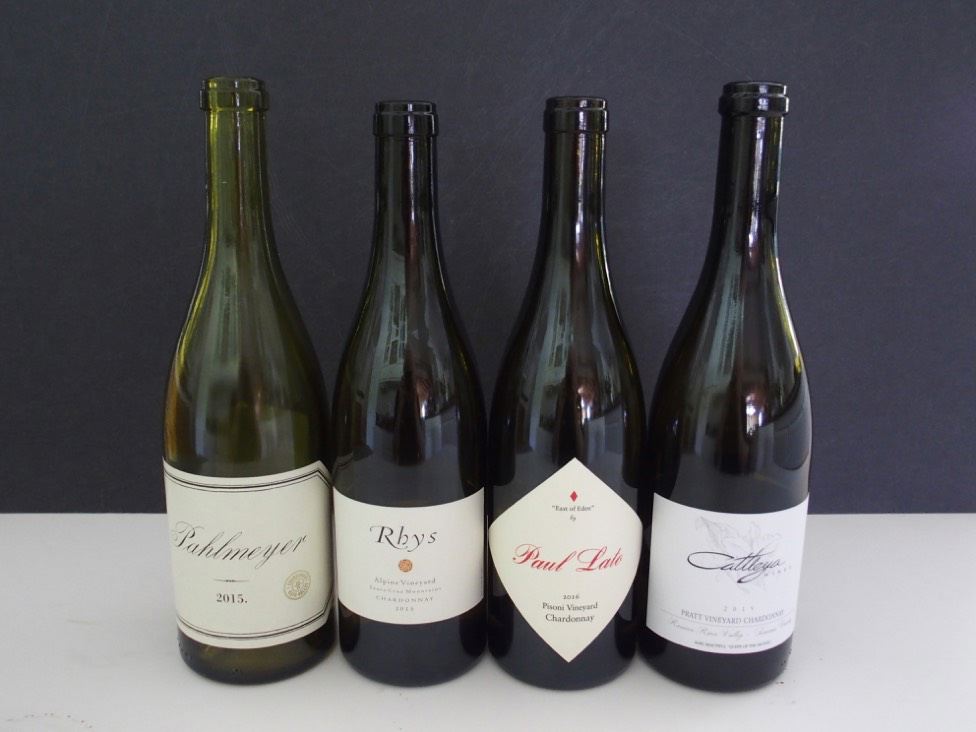
Oregon 2015 LUMOS Wren Vineyard Willamette Valley Chardonnay 12.0% alc., $35. Both slightly under-ripe features of lemon-lime and green apple as well as riper notes of pear and white peach. A bolt of acidity runs through the wine. 2015 Gran Moraine Yamhill-Carlton Willamette Valley Chardonnay 13.0% alc., $45. A leaner, dry, slightly austere style featuring citrus and green apple fruits. Nicely integrated acidity and the slightest oak input. 2015 Haden Fig Juliette Willamette Valley Chardonnay 13.5% alc., $40. Steely with notes of graphite. Citrus and pear flavors that hold on to the finish. 2016 Walter Scott X Novo Eola-Amity Hills Chardonnay $65. Acid and citrus driven, with complimentary notes of spice, toast and brioche. Very stylish, with brightness, vibrancy and edginess. Slightest sulfur on the nose. One of my favorites in this tasting.
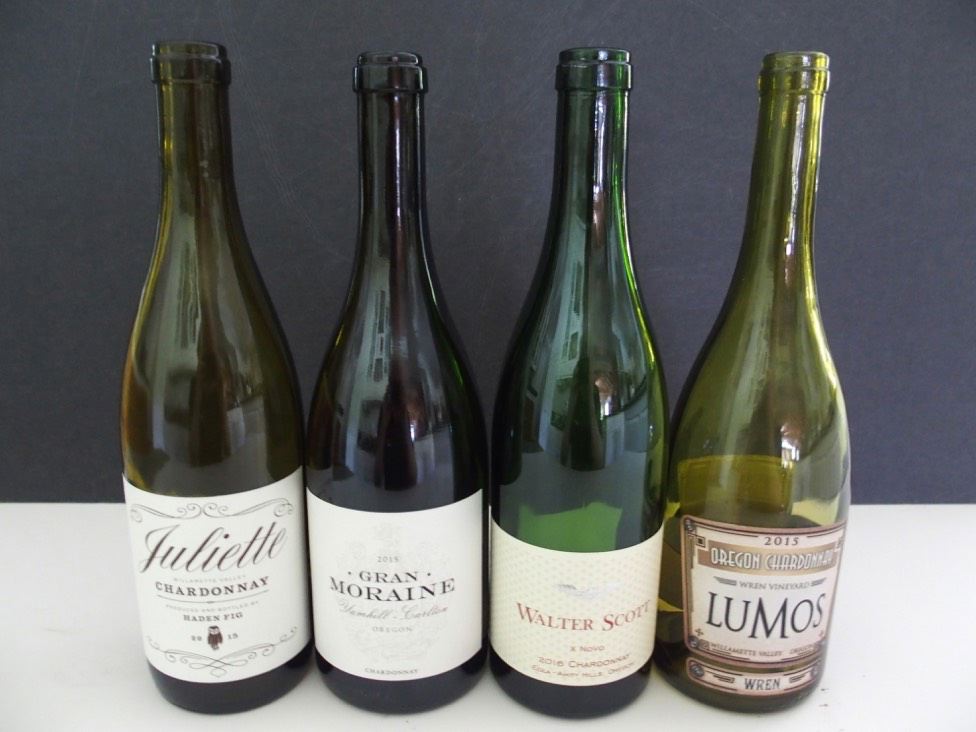
Australia 2016 Dexter Mornington Peninsula Chardonnay 13.5% alc., $40, screwcap. Aromatically pleasing with scents of citrus, peach, and spice. Slightly viscous ending with a burst of citrus and a touch of matchstick. Many in our tasting group loved this wine. 2016 Tapanappa Tiers Vineyard 1.5m Picadilly Valley South 13.9% alc., pH 3.12, $55. 2018 Decanter World Wine Awards Best in Show. Vineyard planted in 1979, the first vineyard planted in the Adelaide Hills. Picadilly Valley is the second coolest and wettest location in South Australia. Dijon clones 76 and 95. Noticeable flinty, sulfur notes on the nose and finish. Stone fruits, grapefruit and brioche, finishing a bit sour on a soprano note. My least favorite wine in the tasting. 2016 Sorrenberg Victoria Chardonnay $55. 30% new French oak. Complete malolactic fermentation. 10 months of lees contact with stirring. I liked this wine a lot with its mineral-imbued, floral and spice nose. There is a charming spice from Sirugue French oak aging. Several tasters liked this wine including me.
New Zealand 2016 Kumeu River Hunting Hill Chardonnay $60. Vineyard first planted in 1982. Often a significant contributor to the Estate Chardonnay. Enchanting wine that us very giving but not heavy. Plenty of citrus, stone fruit and mineral aromas and flavors to please. Beautifully balanced and charming. One of my favorite wines in the tasting.
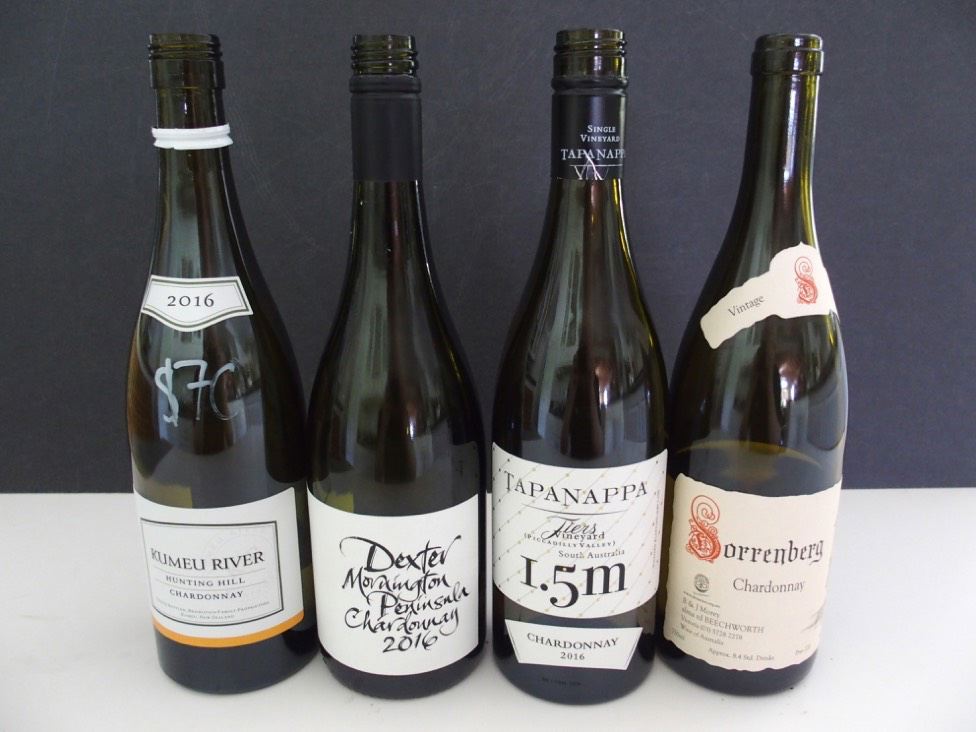 I thought the California, and Australia Chardonnays and one New Zealand Chardonnay were similar in style. The Oregon Chardonnays tended to be a tad leaner, lower in alcohol, with more acidity ( and less expensive). None of the wines in this tasting had noticeable diacetyl (butter) character. The Australian Chardonnays tend to feature a flint/matchstick character (volatile sulfur compounds) which may or may not be pleasing depending on the intensity. Top end Australian consumers do like the struck match character in Chardonnay if it is not too strong. This matchstick character is similar to that found in some French white burgundies such as Coche-Dury and Pierre-Yves Colin-Morey. The flint character tends to be very subtle and often completely absent in domestic Chardonnays.
More Recently Tasted Chardonnay
2015 Byron Bien Nacido Vineyard Santa Maria Valley Chardonnay 14.1% alc., 300 cases, $40. Clones 4 and 95. Barrel fermented with 100% malolactic fermentation and aged in French oak barrels, 69% new. · Moderate golden yellow color in the glass. The nose offers aromas of buttered popcorn, honey, pineapple core and lemon rind. Creamy in the mouth with well-ripened fruit flavors of yellow apple, pineapple, mango and pear. A bold, rich wine with nicely integrated acidity and a deft touch of oak. Well crafted in this fruit and oak driven style. Score: 92
2015 Byron Nielson Vineyard Santa Maria Valley Chardonnay 14.4% alc., 400 cases, $40. Primarily Wente clone from cuttings obtained from the original Wente clone planted on the estate in 1964. Barrel fermented with 100% malolactic fermentation and aged in French oak barrels, 52% new. · Moderately dark golden yellow color in the glass. Aromas of citrus peel, yellow grapefruit and ripe apple lead to a discretely rich styled wine with ripe flavors of pineapple, lemon and yellow peach underlain with complimentary oak. A good cut of acidity maintains a refreshing vibrancy. Score: 92
2015 Gran Moraine Yamhill-Carlton Willamette Valley Chardonnay 13.0% alc., $45. · Moderate golden yellow color in the glass. Aromas of ripe apple, pear, mango, custard and cold steel. Nicely composed with seamless balance, offering flavors of spiced apple, citrus, juniper berry, honey and baked bread. Easy going, with a silky texture and a crisp finish. Score: 91
2016 Kessler-Haak Santa Rita Hills Chardonnay 14.6% alc., 360 cases, $35. Vintner grown clones 95 and 76. · Moderate golden yellow color in the glass. Aromatically pleasing scents of sea breeze, lemon-lime, and buttered toast. Moderately rich, yet clean and refreshing, with flavors of lemon, pineapple and white peach. Slightly oily in mouthfeel with a vibrant personality. Score: 91
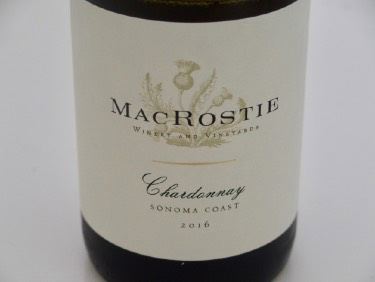 2016 MacRostie Winery & Vineyards Sonoma Coast Chardonnay 14.3% alc., 18,227 cases, $25, screwcap. Sourced from multiple distinguished vineyards in the Sonoma Coast, Carneros, Russian River Valley and Petaluma Gap. 85% of the juice was racked into French oak barrels for fermentation, 20% new. 15% of the juice stayed in stainless steel tanks and never went to barrel. The wines were aged on the lees for 6 months both in tank and barrel, with occasional stirring. · Light golden yellow color in the glass. This is a very classy and comforting wine, featuring aromas and flavors of lemon, white peach, baking spices and a hint of toast. Good on the attack with a pleasingly smoothing texture, finishing on a lemony high note. Very harmonious and easy to like. Impressive quality considering such a large production and modest pricing. Score: 92
2016 Morgado Cellars Steiner Vineyard Sonoma Mountain Chardonnay 14.2% alc., $62. · Moderate golden yellow color in the glass. Complex nose offering aromas of haystack, graphite, lemon, peach, spice, shortbread and nutty oak. A rich and boldly styled wine with some heaviness. Creamy on the palate, with flavors of lemon, ripe pineapple, apple, caramel and toast. The texture is really quite dreamy, but there is a sense of alcohol on the nose and finish. Score: 89
2015 Open Claim Willamette Valley Chardonnay 13.5% alc., $75, DIAM closure. Sold in three bottle allocations. Winemaker Tony Rynders. · Moderately light golden yellow color in the glass. The nose is infused with citrus and oak driven aromas of honey on toast, shortbread and vanilla creme. Nuanced aromas of floral blossom, dried grass and wax add interest. Slightly creamy in the mouth, with heady flavors of lemon, grapefruit, white peach and banana, with oak compliments. Nicely integrated acidity, with some finishing length. Score: 92
2015 Paul Hobbs Richard Dinner Vineyard Sonoma Mountain Chardonnay 14.1% alc., $80. · Moderate golden yellow color in the glass. Very appealing aromas of crystallized lemon, white peach, brioche and a subtle spice and floral note. Some richness in the mouth but not heavy, with flavors of lemon, peach and pineapple underlain with a friendly bit of toasty oak. Agreeably creamy in the mouth, submerged acidity yet lively enough, offering some length on the very satisfying, lemon-fueled finish. Score: 95
2014 Sweetzer Cellars Santa Maria Valley Chardonnay 14.1% alc., pH 3.37, TA 0.73, 250 cases, $28. Vines planted in 2007. Clones 4, 76, 95 and 96. Native and proprietary yeasts. Fermented 60% stainless steel and 40% neutral oak. Aged 18 months in French oak barrels, 25% new. · Moderately light golden yellow color in the glass. Aromas of kiwi, grapefruit and wax with some unusual whiffs. Flavors of lemon and créme brûlèe in a crisp, tightly wound style with only a hint of oak vanillin. Score: 88
2014 Sweetzer Cellars Presqu’ile Vineyard Santa Maria Valley Chardonnay 14.4% alc., pH 3.33, TA 0.75, 137 cases, $40. A barrel selection. Clones 4, 76, 95 and 96. Fermented in 60% stainless and 40% neutral oak. Aged 18 months in French oak barrels, 25% new. · Moderately light golden yellow color in the glass. Scents of butter, yellow nectarine, wax and toasty oak entice. More concentration and length in the mouth than the Santa Maria Valley bottling with valued flavors of lemon, honey and toasty oak. The acidity is also better integrated in this wine. Score: 90
2016 Trader Joe’s Lot #87 Grand Reserve Sonoma Coast Chardonnay 14.8% alc., $12.99. Vinted and bottled by AVID Winery, Sebastopol. · Pale golden yellow color in the glass. Up front aromas of butter, lemon and pineapple. Light in weight with good acidity, featuring flavors of citrus, apple, nuts and caramel. Bright and lively with a silky texture and integrated alcohol. This wine will attract Chardonnay fans at this price. Score: 88
2015 Wildberry Estate Reserve Margaret River Australia Chardonnay 13.0% alc., $30, screwcap. Imported by Southern Starz, Inc., Huntington Beach, CA. · Moderately light golden yellow color in the glass. Flinty reduction on the nose with added aromas of pear, lemon-lime and seaweed. Crisp and bright in the mouth, with flavors of lemon custard and pear fruits with a flinty (mercaptan) bearing. The bright citrus-imbued acidity drives the wine’s vibrancy and the lemony finish. Your enjoyment of this wine will depend on your attraction to volatile sulfur compounds in Chardonnay. Score: 89
Pinot BriefsKosta Browne Opens New Tasting Venue The winery will open “The Gallery” on August 9 at its Sebastopol winery located in The Barlow. Customized tasting will be available for mailing list buyers as well as those on the waiting list. Guests will also be able to taste the winery’s newest label known as the Observation Series, produced by Kosta Browne winemaker Nico Cueva. The Gallery will be open Monday through Saturday by appointment. Visit www.kostabrowne.com. The Donum Estate Sculpture Garden A special sculpture collection presented by the winery owner Allan Warburg features over 35 works on display by notable artists. The Donum Estate has also used some of the art on their latest labels. Visit www.thedonumestate.com. Net Wine Club Member Growth Rate
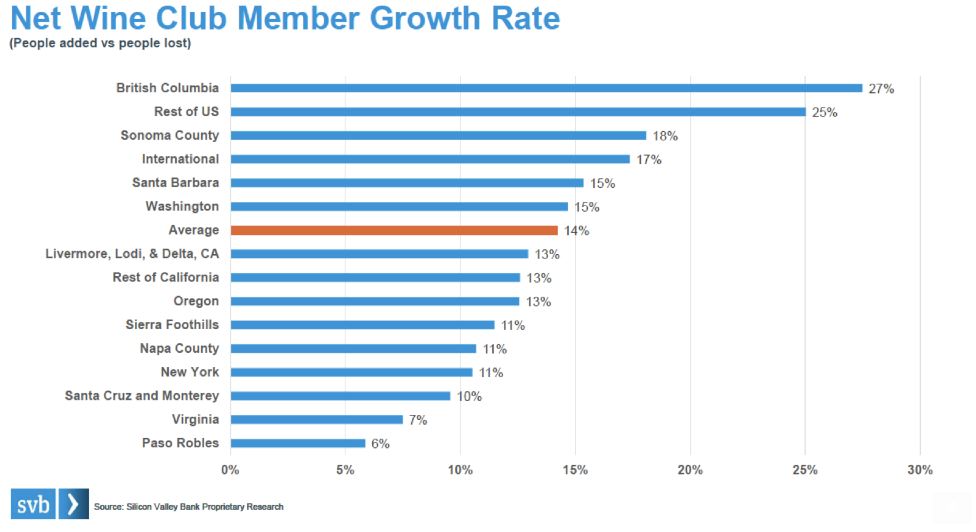 ¡Salud! Auction Now Available Online The annual !Salud¡ Oregon Pinot Noir Auction, held each year in November, will now add auction bidding online in 2018 beginning July 17. The auction offers 40 lots of 12-bottle cases of exclusive !Salud¡ cuvées of Oregon Pinot Noir from the 2017 vintage. The 27th annual November celebration has been refigured. The Big Board Auction and Pinot Party will be held at Ponzi Vineyards on Friday, November 9. On the following Saturday, the Grand Dinner and Live Auction will be held at Domaine Serene’s Clubhouse. !Salud¡ has raised over $15 million to date to provide healthcare services to Oregon’s vineyard workers and their families. Bounty of Yamhill County (BOYC) This festival, now in its sixth year, will be held August 24-26, 2018. The event celebrates the chefs, wineries and family farms of Yamhill County. Additional activities include hiking, hot air ballooning and horseback riding. The BOYC benefits the Yamhill Enrichment Society, a non-profit that supports projects in education, the arts, food and agriculture. Cannabis Legalization Leads Oregon into a Major Dispute Moe Momtazi farms a large biodynamic vineyard in the McMinnville AVA. He is currently in an ugly court battle with cannabis farmer Richard Wagner who owns a property next door. Read the whole story that is probably only one of many court battles that will play out in California and Oregon wine country in the near future. https://theoutline.com/post/5062/wine-and-weed-go-to-war-in-oregon-maysara-vineyards?zd=2&zi=oyt4ehn4. Latest Study Affirms J-shaped Curve for Mortality A new study published in PLoS Med, https://doi.org/10.1371/journal.pmed.1002585, provides further affirmation of the J-shaped curve for mortality and increase in incidence of cancer with larger intake of alcohol. This population-based cohort study of almost 100,000 older subjects were followed for a median of 8.9 years. The authors reported that light to moderate drinking was associated with lower total mortality, but the risk of incident cancer increased with greater alcohol consumption, especially the intake of beer or spirits. The analysis indicated that the slightly increased risk of cancer associated with moderate alcohol consumption was less than the beneficial effect on mortality. In other words, while even light to moderate drinking may be associated with a slight increase in the risk of certain cancers, such drinking still favorably affects the overall risk of mortality.
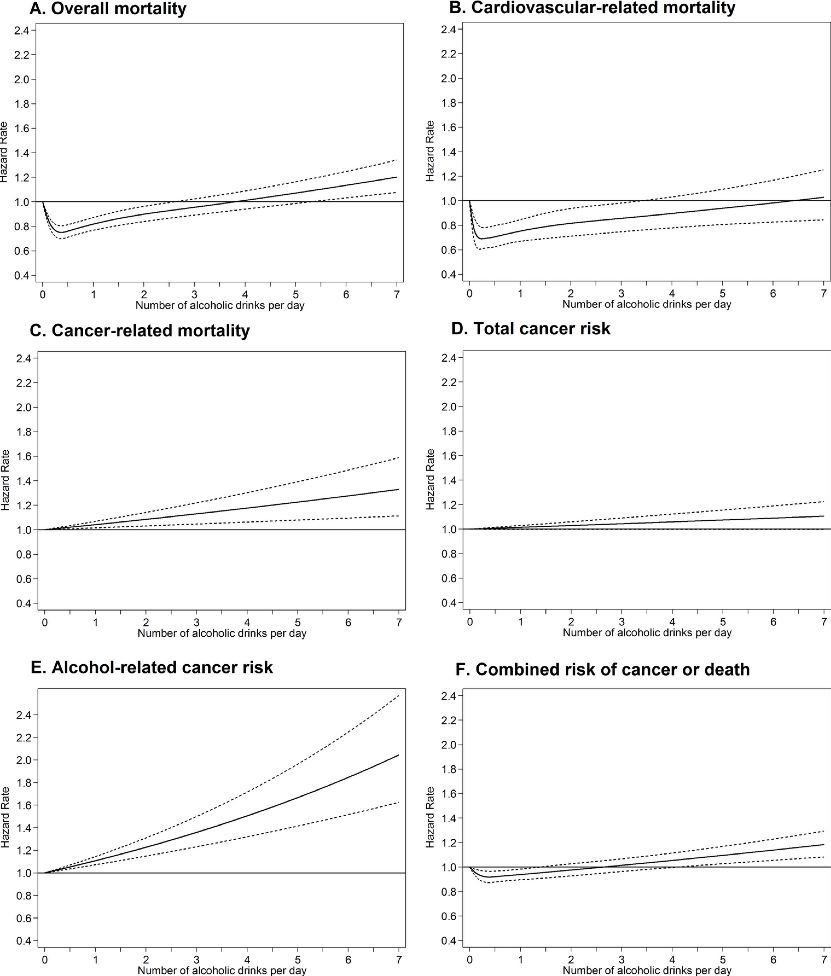 West of West Wine Festival is Back West Sonoma Coast Vintners present the West of West Wine Festival on Saturday, August 18, in Occidental, California, at the Occidental Center for the Arts. VIP Library Tasting is from 1:00-2:00 p.m. ($125) and the Consumer Tasting is from 2:00-5.00 p.m. ($100). Participating wineries include 32 Winds, Alma Fria, Banshee Wines, Ceritas, Crossbarn, DuMOL, Emeritus Vineyards, Ernest Vineyards, Failla Wines, Flowers Vineyard & Winery, Fort Ross Vineyard & Winery, Freeman Vineyard & Winery, Gros Ventre, Hirsch Vineyards, Joseph Phelps Freestone Vineyard, Littorai Wines, MacPhail Wines, Occidental Cellars, Peay Vineyards, RAEN, Red Car, Senses, Small Vines and Wayfarer. For information and tickets, visit https://www.eventbrite.com/e/west-of-west-festival-occidental-tickets-46931260664?aff=estw&utm_source=tw&utm_medium=discovery&utm_content=attendeeshare&utm_campaign=social&utm_term=listing Kanzler Family Vineyard Farm Stay The Kanzler family home, located on the site of Kanzler Vineyard in the Russian River Valley AVA, has been updated and converted into a wine country retreat. The family built the home and lived in it for more than 25 years and are now thrilled to be able to share it. The house has 4 bedrooms, 5 baths with many amenities including patios, pool, sun deck, outdoor fire pit, hot tub and spacious grounds. Reservations are accepted for up to 8 guests. For a complete description of the house, calendar availability and reservations, visit the AirBnB listing. $1,425 per night.
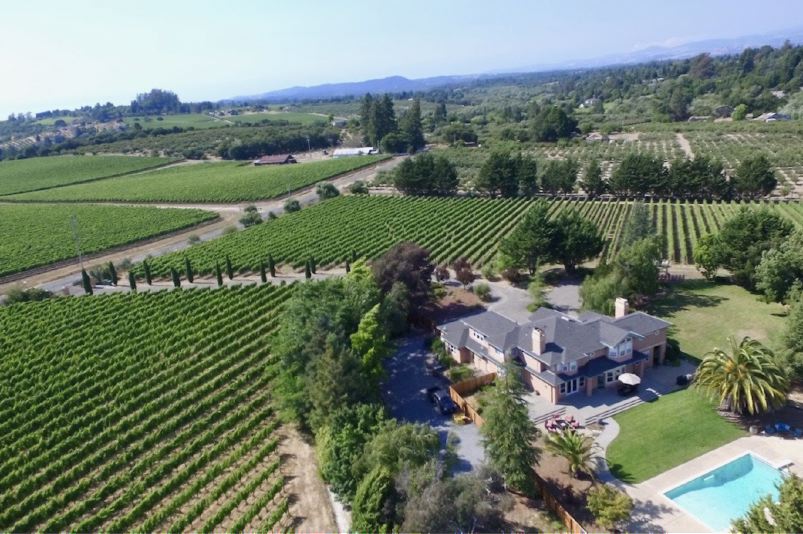 Amorin to Eradicate TCA by 2020 The world’s largest cork producer, Amorim, plans to have a nondetectable TCA guarantee for every natural cork stopper beginning in 2020. Amorim sold 5.4 billion corks in 2017 Premium Winery Sales and Margins Flat, Sales Growth Down
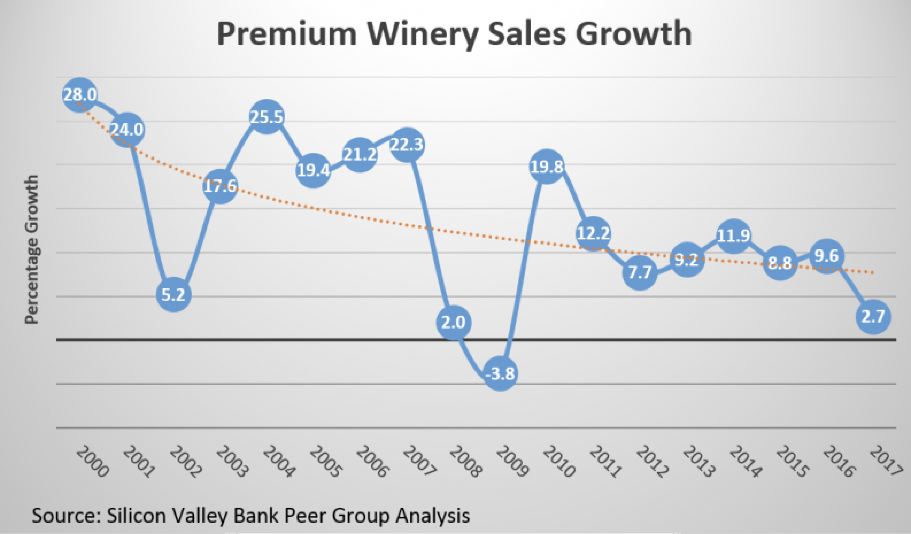
|